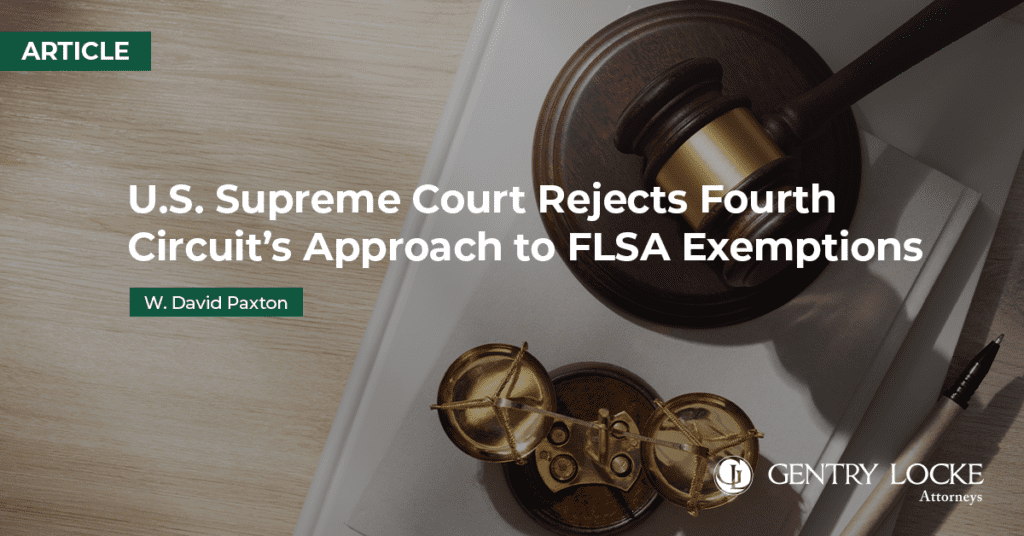U.S. Supreme Court Rejects Fourth Circuit’s Approach to FLSA Exemptions

On January 15, 2025, a unanimous Supreme Court ruled that the preponderance of the evidence standard should be used by courts when determining whether an employer has proven that an employee is exempt and not eligible to be paid overtime.[1]
Justice Kavanaugh began his opinion by noting that under the Fair Labor Standard Act (“FLSA”) certain categories of employees are exempt from the minimum wage and overtime pay requirements. Exempt employees “can range from baseball players to seaman to maple syrup processors to software engineers to fire fighters.” The FLSA places the burden on the employer to show that an exemption applies. For more than thirty (30) years, the rule in the 4th Circuit required employers to prove the existence of the exemption by “clear and convincing evidence,” a more exacting level of proof than a mere preponderance.[2]
The specific issue in this case was whether certain employees worked “in the capacity of an outside salesman.”[3] After a nine (9) trial, the district court concluded that the employer had failed to prove that these employees qualified for the outside salesman exemption. Instead, the court found the employees primarily executed the terms of sales already made rather than making new sales. On appeal, the employer challenged the use of the “clear and convincing” standard, but the Fourth Circuit affirmed the District Court’s decision noting that it was bound by the existing precedent. The Supreme Court noted that the Fourth Circuit currently stood alone in requiring employers to prove FLSA exemptions by the clear and convincing standard.
The Supreme Court found no basis in the FLSA or the Constitution to impose the stricter standard of proof, and it was not persuaded by the employee’s arguments for heightened standard. The court noted that other workplace protections (like eradicating unlawful discrimination) is subject to the lesser preponderance of the evidence standard and found that the use of a heightened standard could not be justified based on the claim that the employer controls most, if not all of the relevant evidence relevant even though most plaintiffs don’t have the resources to litigate these cases. Reversing the Fourth Circuit, the Supreme Court remanded the case for further proceedings that would apply the lesser preponderance of the evidence standard.[4]
In E.M.D Sales, the Supreme Court has leveled the playing field for employers in Virginia, and elsewhere in the 4th Circuit. This ruling can and likely will be used by employers to challenge the outcomes in earlier decisions which found exemptions had not been established because the court used this more onerous standard in reaching the decision. Nonetheless, employers must remember that they will have the burden to prove that an exemption applies, and its evidence must be sufficiently compelling to persuade a court that it is more likely than not that the employee meets the various criteria required by the FLSA and its regulations to establish the exemption exists.
If you have questions regarding the FLSA, overtime rules, or other compensation issues, please contact any member of the Gentry Locke Employment team.
[1] E.M.D. Sales, Inc. v. Carrera, 604 U.S.__ (Jan. 15, 2025).
[2] Shockley v City of Newport News, 997 F.2d 18,21 (4th Cir. 1993); Desmond v PNGI Charles Town Gaming, 564 F.3d 688, 691 (4th Cir. 2009)
[3] In EMD Sales, the employer was an international food distributor, and the sales representatives managed inventory and took orders from grocery stores that used their products. Several of these sales representatives sued claiming they were not exempt and should have been paid overtime. The employer admitted the employees worked more than 40 hours without receiving overtime but argued they were within the “outside sales” exemption.
[4] On remand the district court may still find that the employer failed to meet its burden under the preponderance standard, but that will likely require a new trial.





